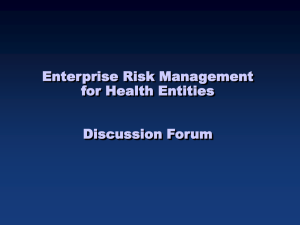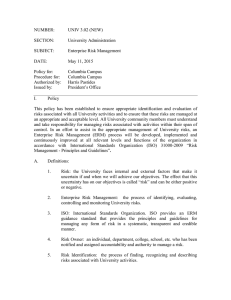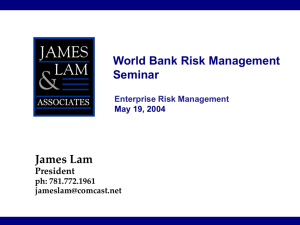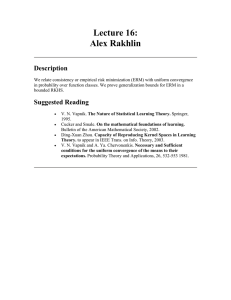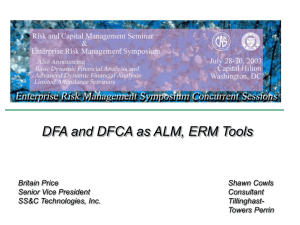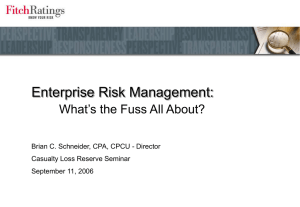Enterprise Risk Management September, 2008 Michael E. Angelina, ACAS, MAAA
advertisement
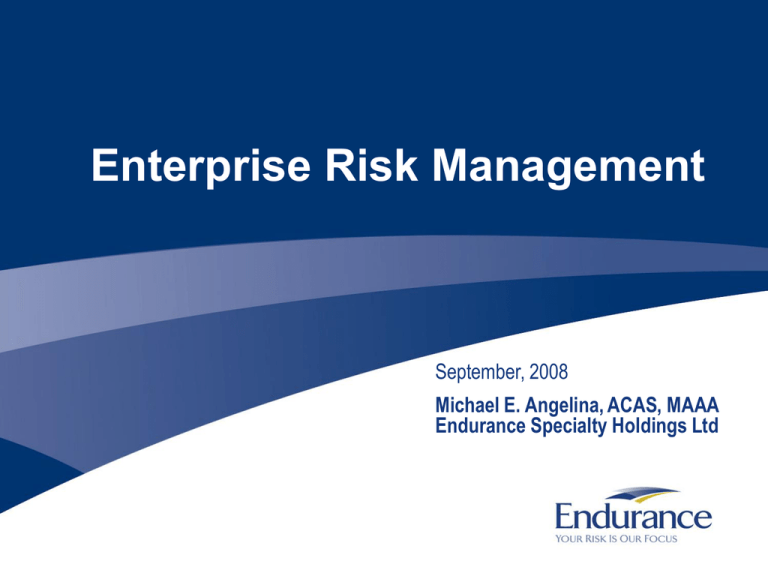
Enterprise Risk Management September, 2008 Michael E. Angelina, ACAS, MAAA Endurance Specialty Holdings Ltd 2 Initial Thoughts Enterprise Risk Management New fad or a step into a new frontier ERM due to its name is thought to be defensive Manage risks to protect downside ERM is strategic weapon (even within reserving) Process of understanding the drivers of risk and the impact to underwriting decisions can make you a strategic partner in your organization. Think portfolio theory and risk levels ᅳ Avoid too much focus on individual cells at the ERM level Technology is our friend Analytical insights can takes us to the next level Economic Capital Modeling ERM Objectives/Principles Optimally manage the company’s capital Required return on capital Eliminate risks that threaten solvency/viability Target maximum aggregate level of risk given range of opportunities Manage volatility – Expected Value Curve Understand, manage, mitigate Shape business by taking risk we can quantify Risk mix, diversification, hedging Create behaviors that reinforce ERM culture Internally and externally 3 Process Silos and Integrated Approach ERM – Initial Phase Silo approach – focus on broad categories ᅳ Identification, Measurement, Management □ Communication by individual risk owners ERM – Second Phase Bringing it all together – Integrated Approach ᅳ Holistic approach / Connecting the silos □ Dashboards can be helpful - Stress test different scenarios ERM Process – Third phase Correlation Analyses ᅳ Need to reflect interactions with other stakeholders (eg Enron effect) ᅳ Examples □ Catastrophe events on property coverages, investments in cat bonds, mortgage backed securities □ Pricing errors and impacts on loss reserves Adding value by understanding other parts of business Understanding and communicating - this is cultural 4 Execution Risk Categories - Identification Separate Risks into General Categories Primary ᅳ Five broad categories Consequential (downward spiral) ᅳ Based on primary risk or event □ Liquidity, Reputation (client/investor), Rating agency / Regulatory, etc Overall Risk Tolerances derived at organizational level Percent of equity limits, Rating agency trigger – capital adequacy levels, Liquidity Additional tolerances should be established for all primary risk categories Levels of investments, peak exposure zones, casualty premium, etc Controls Processes, guidelines, models & data, external reviews, risk assessment process, internal audits, Sarbanes-Oxley process, disaster recovery planning & testing, succession planning 5 Execution Measurement of Risk Categories Select risk owners / gatekeepers of the broad risk categories Identify the various types of events/risks associated with each of the primary categories Change in asset value, movement in interest rates, large property/casualty event (hurricane, earthquake, Enron), adverse claims trends, etc Measure financial and operational impact to organization Balance sheet, liquidity, capital requirements Contingency planning Define tolerances for such events/risks Percent of capital, cash-flow, change in rating agency capital Establish controls to monitor risk exposure within established tolerance levels and to enhance risk profile Manage business around such thresholds Optimally at the point of sale 6 Economic Capital Model Risk Assessment –Pricing Example Developed a model that assesses pricing risk Produces a set of risk-capital metrics Monitors level of capital deployed in the business units across group. Allows for better measurement of the marginal return on capital Real-time basis, for each contract in our portfolio Manages unique interaction of each contract with others in portfolio Based on the geographic distribution of exposures for property. Results in a significantly more efficient portfolio In terms of the capital required to support it ᅳ Relative to typical industry position Supports a broad array of risk and capital management issues 7 Economic Capital Modeling Implementation Issues/Challenges Lack of full transparency Black box stigma attached Much noise when revisions were made that changed results Willingness for many to embrace technology Resistance to models and ability to forecast (predictive value) ᅳ Used to differentiate like risks Full commitment from executive level Non-traditional way of thinking People are generally open to change ?! ᅳ Real time examples made this easy to grasp Too focused on defensive uses initially Desire to seek opportunistic risks Understand outcomes outside the norm ᅳ Returns too good to be true, probably are 8 Other Thoughts Communication Consider the Audiences Management ᅳ Executive team, Reserve committee, Risk committee Board of Directors (Audit or Underwriting Committee) ᅳ Sarbanes Oxley, put risk in context with other risks External (The Street, Rating Agencies, Regulators) □ Caution on how the message is perceived Consider the Message Move away from the point estimate ᅳ Embrace the range, communicate the volatility ᅳ Don’t be Pollyanna Communication of drivers allows management to make better decisions ᅳ Consider risks in the reserves when making investment decisions 9 Other Thoughts Strategic Planning Three approaches Contingency planning ᅳ What we will do if/when this happens □ Need to model both Sensitivity analysis ᅳ Focus on cause and effect – the drivers □ Impact and immediacy Scenario analysis ᅳ More than simulation □ Present different paths under different assumptions ᅳ Look at the external factors as well as internal □ Non-modeled events, undervaluation, demand surge, point in cycle Portfolio Theory Remember this is one part of the entire group of risks in portfolio 10
